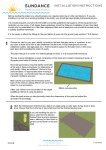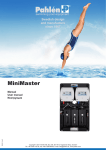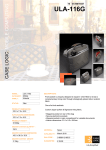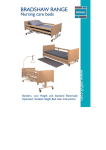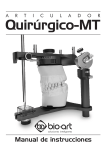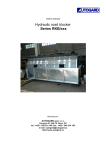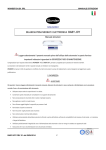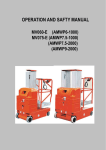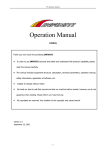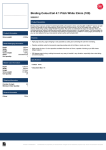Download Installation manual 1.5
Transcript
INSTA LLATI ON INSTR UC TIONS Before starting the project you should acquire any required planning or other permissions. If you are installing in or near to an existing building or boundary you should get appropriate professional advice. You should acquaint yourself with the health and safety guidelines that apply to all the equipment and materials you are using. At all stages these guidelines should be followed. Installation of gas-fired plant should only be undertaken by a Gas Safe registered fitter and all electrical work should be carried out by a suitably qualified technician. It is far easier to attach the fittings to the pool before it goes into the ground (see sections 7 & 8, below). 1 Choose the site for your pool. Ideally it should be flat land that gets plenty of sunshine, is not too close to trees but which is also sheltered from the wind. Avoid underground services (telephone cables, sewage pipes etc.). There should be space for the plant room, which occupies about 2m3 excluding the boiler (if used). The plant may go in a corner of a nearby garage or shed, or in a purpose-built enclosure. The key to good installation is good compaction of the base and constant checking of levels. A Roman I pool holds over 50 tonnes of water. Excavate pool area to required depths (see table at the end of these instructions for dimensions of pool shells). Allow an additional 100mm for the sand bed base. Or appropriate depth if laying a concrete base - a concrete base may be required if ground conditions are poor. Mark out the pool using the dimensions at the back of this manual, adding 300mm all round the sides for over-excavation. 300mm over-excavation Allow only 100mm over-excavation on the depth. When the pool arrives on site physically check the dimensions of the pool and adjust the groundwork accordingly. 2 Mark the finished pool shell level as a datum on pegs using a water pipe, dumpy level or laser level. Ensure that this is the top of pool shell level not the finished paving level. If you are installing the pool indoors, start from the desired finished floor level and measure down, allowing for floor finish to get the correct level for the pool shell. PG 1/8 V 1.5 (1305) INSTA LLATI ON INSTR UC TIONS 3 Excavate pool area to required depths (see table at the end of these instructions for dimensions of pool shells). Allow an additional 100mm for the sand bed base or appropriate depth if laying a concrete base. Dimensions shown in mm 4 In clay soil or on a high water table it is vital to install external land drains with an accessible sump and, if necessary, a pump. We would advise you consider doing this anyway. Use flexible land drains (from a builders merchant) and lay them to terminate in a sump dug at the edge of the cavity at its lowest point. Place a heavy-duty plastic bucket, with its base perforated several times, in the sump. Make a hole in the side to fit the drain. Fill bucket with gravel. Run 450mm drainpipe from the sump vertically to ground level (allowing for paving etc.). Cap off with an inspection cover. An electric submersible pump can be lowered through this pipe to remove any build-up of water. In extreme cases the pump will need to be operating nearly all the time so a pump with a float switch may be advisable. Poor ground conditions may require you to put the pool on a concrete sub-base with sand laid on top. If in doubt, contact Sundance Pools. PG 2/8 V 1.5 (1305) INSTA LLATI ON INSTR UC TIONS 5 Lay a bed of clean soft sand and compact it using a plate vibrator. For accurate results place lengths of galvanised pipe at either side of the bottom of the hole and ensure that they are at the appropriate levels. A length of timber laid edgewise between the pipes can then be used to level off the sand (see diagram). 6 Some pool models have reinforcing ribs across the base for transportation purposes. Before placing the pool into the excavation remove these ribs from the underside of the pool shell. Cut the fibreglass saddles about 25mm from the pool shell (see diagram) and carefully remove timbers. You may need to prise the remaining fibreglass from the timber with a blunt blade. Do not lever the timbers against the pool shell as this may cause damage. 7 Install fittings to pool: underwater light, return jets, skimmer, counter current (if applicable) etc. The light is normally fitted into the deep end wall or side wall of the pool (but the Cottage pool has two lights fitted in the steps.) Ensure the light is fitted on a flat surface. Consider carefully the position of the return jets and skimmer box. If there is no counter current unit to be fitted, the skimmer box should be fitted at the deep end and the return jets opposite it at the shallow end. The jets should be positioned and subsequently adjusted to create a good swirl in the water. If a counter current unit is to be fitted, the skimmer box should be fitted to the side of the pool. Bear in mind the position of the plant room to shorten the pipe run. Some pools with steps require the return jets to be positioned on the side of the pool. Adjust the swirl so that it keeps the steps clean. PG 3/8 V 1.5 (1305) INSTA LLATI ON INSTR UC TIONS 8 Pay special attention to health and safety guidelines at this stage: it is essential that you use suitable respiratory protection when cutting and abrading fibreglass. Indoors you should ensure that the area is well ventilated. Outdoors you should ensure that co-workers are not downwind of the cutting operation. Return jets should be positioned on a flat surface just below the reinforcing rib where possible. They require a 60mm circular hole. To fit any equipment to the pool shell, mark out the position of the unit on inside of pool. Cut out the 60mm holes with a hole cutter or jigsaw (with a jigsaw ideally use a tile cutting carborundum blade). Check aperture is the correct size. Clean off the bitumen paint (non-ceramic pools only) on outer side of pool using a solvent such as petrol. Smooth fibreglass on outside of pool using a sander or in extreme cases an angle grinder. Do not remove too much of the thickness of the pool wall. Clean fibreglass again with solvent to remove dust etc. Fit item using seals and silicon etc. as per enclosed instructions. The skimmer box should be fitted as high up the pool as possible, just under the lip (though the lip should not be removed). First cut out a section of the reinforcing rib (on non-ceramic pools) using an angle grinder. This should be wide enough to accommodate the full width of the box. On larger pools we recommend cutting the reinforcing rib across the skimmer once the pool is levelled up and in the hole. To fit the skimmer hold the faceplate to the inside of the pool and mark the holes at two corners on a diagonal. Drill these out and fix the faceplate using the long bolts and nuts supplied. Drill out the other holes through the faceplate. Then mark for the rectangular cut-out by drawing round the aperture in the faceplate. Remove the faceplate and cut out the rectangle by using a suitable angle grinder and cutting approx. 4mm outside the mark to allow for the lip on the faceplate. Smooth off the exterior of the pool and fit skimmer with seals and adequate sealant. In order to bring the lid of the skimmer up to the finished floor level it may be necessary to use some extension rings available from Sundance Pools. The skimmer box has two holes in the bottom of the cylindrical section. Two threaded plugs are provided, one with a cut-out to allow partial flow and one complete. The complete plug should be screwed into the hole on the pool side of the cylinder and the plug with the cut-out should be discarded, leaving the other hole open to take the pipework. PG 4/8 V 1.5 (1305) INSTA LLATI ON INSTR UC TIONS 9 Place the pool in position. Check that it is at the correct depth and is level. If more sand has to be added beneath it, be sure to compact it well before returning the shell to its position. Once the pool is level, fill it with water to a depth of 300mm in the deep end. Check that the pool has remained level and adjust if necessary. Start caulking under the pool in order to prevent it moving as it fills. Make a barrier under the curve of the deep end all the way round using a stiff 4:1 sand and cement mix (see diagram). Once caulking is complete, check levels once more and re-commence filling the pool with water. END VIEW sand cement mix water depth 300mm 10 Backfilling should be done with a dry sand and cement mix at a ratio of approximately 10:1. Be careful not to allow backfill material to get into the pool. As the pool fills, backfill to within 300mm of the water level. Gently consolidate the sand and cement mixture by foot or with water (if using water be careful not to wash all the cement out of the mixture). Check that pool rim remains in shape: use wooden supports to the side of the cavity if needed to stop it bowing out; if the sides of the pool bulge inwards remove backfill to relieve them. Continue backfilling until you reach the level of the pipework. Be careful to fill the voids fully beneath steps with concrete. Roman ends may need supporting to ensure that they are level. 300mm minimum sand cement mix PG 5/8 Note: for in- V 1.5 (1305) INSTA LLATI ON INSTR UC TIONS 11 Connect the pipework to the fittings by first cleaning the pipe and fitting surfaces with solvent cleaner and then applying glue to both surfaces. PTFE tape should be used on all threaded joints. Check carefully for leaks (pressure test) as the pipes run through the backfill and are inaccessible when the pool is finished. Keep pipe runs horizontal wherever possible. Continue to backfill to within 150mm of the top edge of the pool. Underwater Light (UWL) 12 VOLT The underwater light should be fitted to the pool shell as per the manufacturer’s instructions. The light must be mounted on a flat surface so it may be necessary to mount it higher than the instructions advise due to the curvature of the pool. On the outside of the pool, the union and conduit should be fitted to the light. Use glue and PTFE as necessary. The cable runs inside the conduit and up to the deck box which should be attached to the top of the conduit. The deck box should be mounted flush with the paving and is where the 12V supply from the plant room is connected. The 12V transformer for the light must be mounted in the plant room. 12 Cast a concrete ring around the pool. For outdoor pools allow sufficient slope to the base so that surface water drains away from the pool (at least 20mm fall away per metre of surround). For an indoor pool use flat top coping stones and ensure the concrete has a fall towards the pool so that surface water returns to the pool. paving slabs coping stones (external) patio sub-structure pool shell reinforcing rib (non-ceramic pools only) concrete ring pipework ground PG 6/8 water line sand/cement backfill V 1.5 (1305) INSTA LLATI ON INSTR UC TIONS TYPICAL PLANT ROOM & PIPEWORK SCHEMATIC The below schematic shows a typical plant installation with the addition of solar panels. PG 7/8 V 1.5 (1305) INSTA LLATI ON INSTR UC TIONS Pool (m) Length Width A B D Weight 11.0m 4.3m 435mm 2000mm 185mm 1020mm 1500Kg 30.6m 60,000l 425Kg Roman 9.5m 4.0m 1500mm 1700mm 2000mm 1100mm 700Kg 25.3m 52,500l 368Kg Bolero 7.5m 3.3m 1500mm 1650mm 1000mm 1020mm 450Kg 20.6m 33,000l 230Kg Terrace 6 6.0m 3.3m 500mm 1360mm 500mm 1360mm 400Kg 18.6m 27,000l 190Kg Jetswim 4.0m 2.2m 500mm 1200mm 500mm 1200mm 250Kg 12.4m 9,000l 65Kg Aphrodite 9.0m 3.8m 1000mm 1500mm 1500mm 1500mm 880Kg 25.6m 40,000l 275Kg Aurora 7.5m 3.75m 1000mm 1500mm 1000mm 1500mm 730Kg 22.5m 33,000l 225Kg Olympia 6.2m 3.3m 1000mm 1500mm 1000mm 1500mm 600Kg 19.0m 23,000l 160Kg Solaris 5.5m 3.0m 1000mm 1500mm 1000mm 1500mm 530Kg 17.0m 18,000l 125Kg Sunquest 36 C Perimeter Capacity Salt Note. We advise that under no circumstances should the water be emptied from a pool without referring to Sundance Pools SUNDANC E POOLS C ONTAC T TELEPHONE 01296 71 5071 PG 8/8 V 1.5 (1305)








